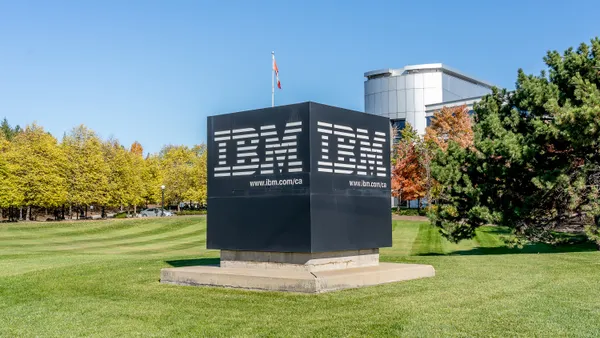Collecting data for the sake of collecting data does little for business value. Businesses know this, yet often operate under the assumption that data will eventually drive insight.
In order for insight to contribute to business value, it cannot be done without asking relevant questions because they set the foundation for advanced analytics and a data-driven culture.
Asking business-centric questions also means a company is working to enrich its data literacy, where "people are aware of what can be done with data," Erick Brethenoux, senior director analyst at Gartner, told CIO Dive in an interview.
As one analyst puts it, data literacy is "information as a second language." But data is still fairly siloed in organizations, making meaningful connections difficult to form.
There isn't a minimum amount of data for companies to collect to justify using advanced analytics, said Brethenoux. It is largely a relative term, previously known as predictive analytics, which used to be called data mining, and has been used for decades.
Today there is more data than ever before, and companies are desperate to use it.
Here are 10 numbers that track, estimate and predict the adoption of advanced analytics:
2020The year by which 80% of organizations will initiate deliberate competency development in the field of data literacy, according to Gartner.
Data mavens, those with the ability to find data to inform business decisions, and newshounds, those who can exploit "a continuous stream of data," represent roles that help sculpt a data-driven culture. The amount of companies that don't think their competitors are using data effectively, according to a West Monroe Partners survey of 300 business and technology leaders. Data is inherently inductive, meaning it can generate new knowledge from previously stored data, but only if it's organized properly, said Brethenoux. The number of large businesses exploring cloud-based management approaches to data, according to Willis Towers Watson. Less than one-fifth of large businesses are currently using a cloud provider, Amazon Web Services, Microsoft Azure to manage their big data. It will be another two years until about half of companies agree AI and ML will reduce time spent by humans on projects. This is largely due to the financial burden and time restraints associated with the infrastructure needed for effective analytics. The percent of companies that can readily access their data, according to West Monroe Partners. Companies that have the ability to access data in real-time usually rely on service providers and third parties, according to Greg Layok, managing director at West Monroe, in an interview with CIO Dive. The value the software segment of advanced analytics and other big data services will increase to by 2027, according to Statista. Companies want to be able to extract insight from data in-house. "Analytics programs are a constant case of experimentation and mining for insights," said Layok, and if companies have the talent and tools in house to use them, they "have more informants for new strategies." The year by which data and analytics will shift focus away from AI, algorithms, customer targeting and optimized ecosystems to more information products and services, data literacy, and societal impacts, according to Gartner. Industries, including healthcare, energy and agriculture, will feel the societal impact including ethics in jobs. The number of organizations that have deployed advanced analytics capabilities, according to a NewVantage Partners survey. But of those, less than 60% have experienced success. Surveyed executives agree that cultural barriers, not technology, are one of the greatest inhibitors of an effective data-driven culture. Having a chief data officer, or an equivalent role, can help cultivate and lead that cultural movement. The number of all relevant business data that is no longer residing in the cloud or data center; companies are moving away from a centralized approach to the distributed approach, which includes the limitation of data collection. The value of connecting data is outweighing the notion of collecting all data. It also means moving analytics to data instead of the opposite. The year digitally-savvy companies will promote "citizen" and specialist users with the deployment of self-service integration and analytics capabilities, according to Gartner's 2019 Planning Guide for data and analytics. This includes operationalizing and scaling analytics efforts within an "organization's broader technology infrastructure." But to be successful, an "arsenal of analytics" should be integrated in autonomous solutions.














